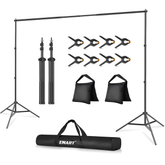Golden Hour Photography: A Complete Guide
What is golden hour? And how can you use it for stunning photos?
In this article, I’m going to share everything you need to know about golden hour photography. So if you’re looking to understand what golden hour actually is, or if you want to improve your golden hour images with some expert tips, you’ve come to the right place.
Let’s dive right in with a simple definition:
What is the golden hour in photography?
The golden hours are (roughly) the first hour after sunrise and the last hour before sunset. But the length of the golden hours can vary depending upon your geographical location and the current season.

What makes this lighting situation so great for photography?
The sun’s position in the sky. Because the sun is at a low angle, it goes through more of Earth’s atmosphere before striking your subject. This produces soft, diffused, flattering light.
Generally speaking, soft light is a photographer’s best friend. It doesn’t create harsh shadows and tends to decrease the dynamic range of a scene, so your images won’t feature dark shadows or bright highlights.
Plus, the golden hour creates a warm color temperature, which can be enhanced (or reduced) in post-processing. This warm color cast is often flattering, like in the photo below:

Five key lighting scenarios for golden hour photography
Golden hour offers five key lighting scenarios (all of which make for great images).
Front light
Front lighting is when your subject faces the sun directly.
During the golden hours, front light gives a warm feel to images. And because the sun isn’t too bright, portrait subjects won’t need to squint.
Front light is very easy to work with and will make a lasting impression.
Backlight
Backlighting occurs when the sun is behind your subject.
During the golden hours, backlight creates a soft, warm, hazy, glowing effect, like this:

Be sure to expose for your subject and enjoy the masterpiece that you create.
Rim light
Rim lighting is when the sun is positioned to create a halo around your subject.
(This halo is especially prevalent when your subject is positioned against a dark background.)
The sun doesn’t need to be directly behind your subject, though – the background just needs to be (relatively) dark. You will have to move around to find the sweet spot to achieve this effect, but a good way to start is by shooting from a low angle.
That’s what I did for this shot:

Sun flare
When stray light hits your lens, you’ll often get a sun flare effect, like this:

During the golden hours, the sun is at the optimal height for beautiful flare. A simple way to achieve stunning flare is to angle your camera and lens so that your subject is partially covering the sun. Then move around (sometimes you only need to move an inch or two left or right) to find an angle that best creates a flare effect.
Another way to achieve a flare is to position your lens and camera so the sun is just out of the frame, as I did for the first image in this section.
Different lenses render different types of flares, so this effect is very fun to try with multiple lenses.
Silhouette
A silhouette is created when your subject is rendered black against a bright background:

Near the end of the golden hours, it becomes fairly easy to achieve a silhouette. Just photograph your subject directly against the light. You can add some contrast in post-processing.
Now, there are several ways to truly take advantage of the golden hours (and achieve consistently stunning images).
1. Observe the sky the day before your photoshoot
The best way to figure out when the golden hour will be at its peak is by observation!
Peek out of the window the day before your photo session. See how the sun moves and how the light changes. Because the sun’s position and timing change very little from one day to the next, that will allow you to get a better idea of what the lighting situation will be like on the day of your shoot.
2. Plan your photo session in advance
No one wants to feel stressed, anxious, or rushed when doing photography, so be sure to plan well in advance.
It’s a good idea to begin setting up for your photo session about 60 minutes before the golden hours begin. That way you have plenty of time to ensure that your subject and equipment are ready for that perfect moment.

3. Watch out for clouds!
Depending on the level of cloud coverage in the sky, the golden hours can change (or not appear at all!).
Clouds can enhance the brilliant sunrise and sunset, or they can block the light entirely.

4. Set your white balance to Cloudy or Shade
By changing your white balance setting, you ensure that your images display true golden hour colors.
Both the Cloudy and Shade white balance settings will add more warmth to your photos – so you can enhance the beautiful look the golden hour is famous for.






